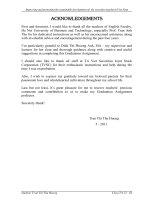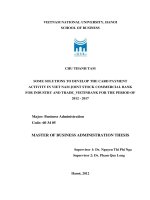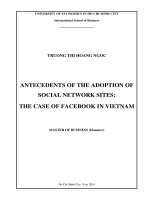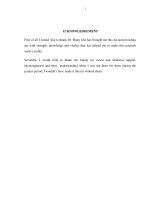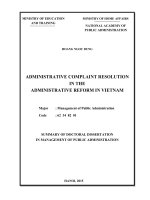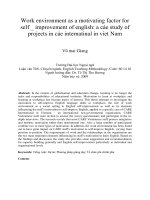Managing activities of teaching and learning the specialized subjects in the vacatinal schools in viet nam under the ministry of trade and industry
Bạn đang xem bản rút gọn của tài liệu. Xem và tải ngay bản đầy đủ của tài liệu tại đây (673.4 KB, 119 trang )
MANAGING ACTIVITIES OF TEACHING AND LEARNING
THE SPECIALIZED SUBJECTS IN THE VOCATIONAL
SCHOOLS IN VIETNAM UNDER THE MINISTRY OF
TRADE AND INDUSTRY
___________________________
A DISSERTATION
Presented to the Faculty of the Graduate School
Southern Luzon State University, Lucban, Quezon, Philippines
in Collaboration with
Thai Nguyen University, Socialist Republic of Vietnam
___________________________
In Partial Fulfillment
of the Requirements for the Degree
Doctor of Philosophy in Educational Management
___________________________
By
NGUYEN THIEN NAM (JOHN)
October 2014
i
APPROVAL SHEET
ii
CERTIFICATE OF ORIGINALITY
iii
ACKNOWLEDGMENT
I could have never completed this work without contributions from
various people and institutions, great respect and gratitude to whom I
endlessly owe.
Professor Apolonia A. Espinosa, my advisor, for her invaluable
thoughts, insightful suggestions and useful guidance throughout the thesis
works;
Committee members of the oral defense for their propositions,
valuable comments, and constructive suggestions, which were of substantial
value to this study;
Professors of Southern Luzon State University (SLSU) and Thai
Nguyen University (TNU) for their insightful lectures in different subjects that
provide me knowledge and technique to develop a good research;
My friends for their meaningful discussion, hospitality and friendship;
and
My parents, wife and children for being my personal source of
inspiration, for their immense love, loyalty, determination and perseverance
even during the most difficult times, without them nothing would have been
possible.
NTN
iv
DEDICATION
This piece of work is lovingly dedicated to
my parents,
wife and
children.
NTN
v
TABLE OF CONTENTS
PAGE
TITLE PAGE ………………………………………………………………..
i
APPROVAL SHEET ……………………………………………………….
ii
CERTIFICATE OF ORIGINALITY ………………………………………..
iii
ACKNOWLEDGMENT …………………………………………………..
iv
DEDICATION ………………………………………………………………
v
TABLE OF CONTENTS …………………………………………………..
vi
LIST OF TABLES ………………………………………………………….
viii
LIST OF FIGURES…………………………………………………………
x
LIST OF APPENDICES …………………………………………………...
xi
ABSTRACT …………………………………………………………………
xii
CHAPTER
I
II
III
INTRODUCTION ……………………………………….……
1
Background of the Study ……………………………….…..
2
Objectives of the Study ………………………………….….
5
Hypotheses …………………………………………………..
6
Significance of the Study …………………………………...
7
Scope and Limitation of the Study …………………….…..
8
Definition of Terms ……………………………………….….
8
REVIEW OF LITERATURE ……………………….……….
11
Conceptual Framework …………………...….………..……
27
Research Paradigm ……………………………...….………
29
METHODOLOGY ……………………………………………
31
Locale of the Study ………………………….………………
31
Research Design …………………………….………………
34
Population and Sampling ………………….…...…………..
34
Instrumentation………………………...…………..…….….
35
Data Gathering Procedure ………………………………….
36
Statistical Treatment …….…………………………………..
38
vi
IV
RESULTS AND DISCUSSIONS ……………………….….
40
Current status of the management of teaching and
learning activities ……………………………………….…...
40
Differences of the teacher and student - respondents’
responses by school in terms of management of
teaching and learning activities …………………………....
53
Problems encountered in the management of teaching
and learning activities the special subjects ……………….
71
Management measure to enhance the teaching-learning
activities of the specialized subjects …………………..…..
74
The principles of building measures ……………………….
74
Management measures to enhance the quality of
teaching and learning activities …………………………….
75
Necessity and feasibility of the proposed management
measures among school managers ……………………………..
V
84
SUMMARY OFFINDINGS, CONCLUSIONS AND
RECOMMENDATIONS
Summary…………………….…………………………….…
86
Findings ………………………………………………………
87
Conclusions ……………………………………………….…
90
Recommendations ……………………………………..……
90
REFERENCES ……………………………………………………………..
92
APPENDICES ……………………………………………………………...
94
CURRICULUM VITAE …………………………………………………….
104
vii
LIST OF TABLES
TABLE
4.1
4.2
4.3
4.4
4.5
4.6
4.7
4.8
4.9
4.10
4.11
4.12
4.13
4.14
PAGE
Weighted Mean Distribution of the Current Status of the
Management of Teaching and Learning Activities in Terms of
Curriculum…………………………………………………………
40
Weighted Mean Distribution of the Current Status of the
Management of Teaching and Learning Activities in Terms
of Faculty…………………………………………………………..
43
Weighted Mean Distribution of the Current Status of the
Management of Teaching and Learning Activities in Terms
of Learners………………………………….……………………..
46
Weighted Mean Distribution of the Current Status of the
Management of Teaching and Learning Activities in terms of
Technical Facilities ………………………………………………
49
Weighted Mean Distribution of the Current Status of the
Management of Teaching and Learning Activities in terms of
Labor Market………………………………………………...…….
51
Differences of the Teacher-Respondents’ Responses by School
as to Curriculum…………………………………………………...
54
Differences of the Responses of the Teacher-Respondents by
School as to Faculty ………………………………………………..….
55
Differences of the Teacher-Respondents Responses by School as
to Learners ………………………………………………………...
57
Differences on the Responses of theTeacher-Respondents by
School as to Technical Facilities for Teaching and Learning……..
59
Differences on the Responses of the Teacher-Respondents by
School as to Labor Market………………………………..……….
61
Differences on the Responses of the Student-Respondents by
School as to Curriculum……………………………………….…..
63
Differences on the Responses of the Student-Respondents
by School as to Faculty………………………………….………….
65
Differences on the Responses of the Student-Respondents by
School as to Learners………………………………………………….
66
Differences on the Responses of the Student-Respondents
by School as to Technical Facilities ………………………………
68
viii
TABLE
4.15
4.16
PAGE
Differences of the Responses of the Student Respondents
as to Labor Market…………………………...………………………
70
Necessity and Feasibility of the Proposed Management
Measures Among School Managers ………………………..…
84
ix
LIST OF FIGURES
FIGURE
PAGE
1
Visual Representation of the Concepts in the Dissertation …
28
2
Input-Process-Output Model of the Study …………………..………
29
x
LIST OF APPENDICES
APPENDIX
PAGE
A
Maps of Respondent Schools ………………..…………….
95
B
Request Letter to Conduct the Survey(To School
Principal)…………………………………………………….…
98
C
Evaluation of the Questionnaire for Content Validation ….
99
D
Questionnaire ………………………………………………...
100
xi
ABSTRACT
Title of Research
: MANAGING ACTIVITIES OF TEACHING AND
LEARNING THE SPECIALIZED SUBJECTS IN
THE VOCATIONAL SCHOOLS IN VIETNAM
UNDER THE MINISTRY OF INDUSTRY AND
TRADE
Researcher
: NGUYEN THIEN NAM (JOHN)
Degree Conferred
: DOCTOR OF PHILOSOPHY IN EDUCATIONAL
MANAGEMENT
Name and Address
of Institution
: Southern Luzon State University Lucban, Quezon,
Philippines and Thai Nguyen University, Socialist
Republic of Vietnam
Adviser
: Dr. Apolonia A. Espinosa
Year Written
: 2014
______________________________________________________________
Viet Nam is aiming to become an industrialized country by 2020.
Technical and vocational education and training (TVET) is central to this
aspiration. To achieve the objectives set by the Government, the Ministry of
Trade and Industry has directed the vocational schools to have positive
innovation in the management of teaching and learning, especially in
specialized subjects. This dissertation aimed to propose management
measures to enhance the teaching learning activities of specialized
subjects. Four (4) typical vocational schools under the Ministry of Industry and
Trade, which are University of Industry of Ho Chi Minh City, Hanoi University
of Industry, University of Quang Ninh Industrial, and Hue College of Industry
were used. Four hundred fourteen (414) teachers and two hundred (200)
students serve as respondents. This research focused on five elements of
education management: curriculum, learner, faculty and staff, technical
facilities for teaching and learning and labor market. The researcher adapted
xii
a questionnaire based on the annual reports of the MOIT and researches
which serve as the main tool in gathering data. The status of the management
of teaching and learning activities was evaluated using weighted mean. The
researcher also used the Chi- Square test of Homogeneity. The main findings
include The current status of the management of teaching and learning
activities in terms of curriculum received average weighted means (AWM) of
3.13 and 3.09, or “agree” for both lecturers and students. When it comes to
faculty and staff, lecturers and students rated the current status of the
management of teaching and learning activities with AWM of 3.03 and 2.90
respectively, falling in the “agree” category. In terms of learners, lecturers and
students rated the current status of the management of teaching and learning
activities with AWM of 3.12 and 2.96 respectively, or “agree”. As to technical
facilities for teaching and learning, lecturers and students rated the current
status of the management of teaching and learning activities with AWM of
2.91 and 2.89 respectively, or “agree”. As to labor market, lecturers and
students rated the current status of the management of teaching and learning
activities with AWM of 3.26 and 2.89 respectively, or “strongly agree” and
“agree” category. Majority of the statements under curriculum, faculty and
staff, learners, technical facilities for teaching and learning as well as labor
market show no significant differences as viewed by both groups of
respondents. Problems encountered in the management of teaching and
learning activities on the specialized subjects were identified to fall under
aspects of curriculum, faculty, learners, technical facilities, and labor market.
A proposed management measure to enhance the teaching-learning activities
of the specialized subjects has been developed to address problems
xiii
encountered in curriculum, faculty, learners, technical facilities, and labor
market.
The proposed management measure resulted in 75.5%, 96.2%,
96.7%, and 95.5% of the respondents indicating its necessity. Likewise,
70.8%, 90.8%, 91.5%, and 78.4% of the respondents maintained the
proposed management measure’s feasibility. The findings provide several and
useful implications for the MOIT to improve the quality of managing activities
of teaching and learning in the vocational schools.
xiv
1
Chapter I
INTRODUCTION
Teaching is a profession that deals more on socializing and
communicating. The subject of the teaching activity are the teachers and for
studying, students. The two activities are not opposites but always parallel in
existence and development of a unified process towards the common goals.
According to Tran Ba Hoanh (2006), teaching activity refers to
imparting knowledge, organizing, directing, controlling and dominating the
operating instructions of the learned knowledge. Teachers guide tasks,
accompany the learners on the path of knowledge in the pedagogy, creating a
cohesive tie between teachers and learners.
Learningis
a
cognitive
activityunder
the
guidance
ofthe
teacherwiththepositiveeffortsofthestudents. Learning activity is not only the
repeatof the lessons, but also a chance to renew a students’ encounter on the
topic,
opportunity
to
usetheknowledgeinthe
enhance
process
creativethinking,
of
absorbing
andcontrolwho
can
thenewknowledge.
Throughlearning, students learn how to use andcontrol knowledge in order to
build their ownpersonalitytobe able toadapt to thesocial requirements.
As mentioned by Seymour (2003), the goal of teaching is associated
with the purpose of the lesson and the course. The goal of teaching is to equip
the learners with knowledge, skills, attitudes and values needed in practical
situations. Specific purposes of the course provide specific requirements for the
teachers and students, which are the direct target in class calculated based on
the specific characteristics of the subjects and the student. The purpose of
teaching is gained by implementation of objective of the lessons and the
2
courses.
Teaching and learning are the main activities of the school and in
which
all
the
school's
activities
are
focused.
Teaching
operations
management system is intended to achieve teaching objectives. In the
schools, teaching operations management involves the labor process of
teacher and learning activities. In order to achieve teaching-learning
effectiveness, the leaders need to identify the objects, contents and methods
of teaching-learning process.
As a move towards meeting the demand for the vocational schools, the
Ministry of Industry and Trade (MOIT) has had education strategy plan for the
vocational schools. One of the key requirements is to innovate the
management activities of teaching and learning the specialized subjects to
improve the education quality.
Background of the Study
Since 1999, Vietnam’s education has changed significantly with the
support of Vietnamese government’s Renovation policy that promoted the
openness to open market and international collaboration and partnership. The
general education system is highly centralized as the Ministry of Education
and Training (MOET) oversees its nation-wide curriculum, teaching standards
and teacher development for the public education. The MOET also has critical
influence on the private general education in terms of curriculum and teaching
standards.
As mentioned by Vietnamese Government (2001), the MOET specifies
that the purpose of general education is to link content to the realities of life
3
and
gears
learning
toward
the
appropriate
psycho-physiological
characteristics and needs of the students. With the goal of providing a basic,
but comprehensive education, the MOET requires that methodologies of
instruction nurture the student’s discipline for self-study and ability to
collaborate and work in teams. By helping students apply learned knowledge
into practice, schools aim to inform and plant the seeds of interests for
students on the possibilities of career paths. This career-orienting approach
will not only promote students’ worldly consciousness and develop their
creativity and self-awareness, but also it will bring them joy, connection, and a
purpose on their path of learning (Dernbach, 2010).
Beside the general education system for the general school aged
students, the MOET also supervises the Vocational and Technical Education
(VTE) in partnership with the Ministry of Invalid and Social Affair (MOLISA).
Students who are more than 15 years old or who do not pass the entrance
exam to public upper secondary schools will have to enroll in the private upper
secondary schools or VTE schools in order to achieve upper secondary
education and receive skill-labor training. The VTE consists of two subsystems: vocational schools and centers specialized in training skilled or semiskilled workers; and the technical vocational school specialized in training
intermediate practitioners in the field of education, economy, technology,
culture and art (Dernbach, 2010).
At present, the Ministry of Industry and Trade has 50 vocational
schools. There are 32 schools, including one (1) school of training and
retraining of civil servants, eight (8) universities, twenty one (21) colleges, one
(1)
vocational
college,
and
eleven
(11)
professional
secondary
4
schools.Eighteen (18) schools including two (2) universities, five (5) colleges, nine
(9) vocational colleges, one (1) professional secondary school, and (1) vocational
school belong to the corporation. One (1) university and one (1) college approved
by the Ministry of Industry and Trade to participate in some activities in the
schools of the Ministry are also included.
Thanks to the proactive measures, vocational training quality in the
vocational schools under the MOIT has been increasingly upgraded,
contributing to improved workers’ quality, economic competitiveness, and
economic growth. Practice has shown that it has met the requirements of
high-tech enterprises in such sectors as telecommunications, electronics,
informatics, etc. Skilled workers are able to master modern equipment and
later they become key workers in many enterprises. Some vocational
schools under the MOIT have been conditioned to train regional and
international technical laborers. Some schools have successfully equipped
laborers with 3G-to-6G welding technology which is recognized in other
countries. As mentioned in the report of the MOIT (2010, 2011, 2012),
vocational training has been closely linked to labor market needs,
contributing to the reduction of unemployment, especially structural
unemployment caused by technological advances. However, from the
current status of education and training in the vocational schools under the
MOIT, it can be seen that there are shortcomings in terms of teacher
quality, infrastructures, education program, as well as curriculum (MOIT,
Annual Reports, 2012). That is why students who graduate do not meet the
demand and requirements of the enterprises, especially foreign companies.
Moreover, curriculum in these vocational schools under the MOIT does not
5
put the specialized subject in the right position. Teachers who cover the
specialized subjects, in some cases, do not meet the requirements (MOIT,
Annual Reports, 2012). For these reasons, the researcher chose to
conduct this study with the hope of contributing in the improvement of the
quality training of the vocational schools under the MOIT.
Objectives of the Study
The study aims to find out the managing activities of teaching and
learning the specialized subjects in the vocational schools in Vietnam under
MOIT with an end view of developing some management measure during the
school year 2012 – 2013.
Specifically, it aims to find answers to the following:
1. Assess the current status of the management of teaching and
learning activities in terms of:
1.1. Curriculum;
1.2. Faculty and Staff;
1.3. Learners;
1.4. Technical facilities for teaching and learning;
2. Evaluate the current status of the management of teaching and
learning activities as to
Labor market;
3. Determine if there is a significant difference between the responses of the
6
teachers and students from the four schools on the management of
teaching and learning activities as to
3.1 Curriculum;
3.2 Faculty and staff;
3.3 Learners; and
3.4 Technical Facilities for Teaching and Learning
4. Find out whether a significant difference exists between the responses
of the two groups of respondents from the four schools as to labor
market;
5. Analyze the problems encountered in the management of teaching and
learning activities the specialized subjects;
6. Propose a management measure to enhance the teaching-learning
activities of the specialized subjects; and
7. Determine the level of necessity and feasibility of the proposed
management measures among school managers.
Hypotheses
There is no significant difference between the responses of the two groups of
respondents from the four schools as to management of teaching and learning
activities with regards to curriculum, faculty and staff, learners and technical
facilities for teaching and learning the specialized subjects.
The responses of the two groups of respondents from the four schools do
not significantly differ as to labor market.
7
Significance of the Study
This study attempted to propose management measures in enhancing
the activities of teaching-learning the specialized subjects to improve the
quality of these activities in vocational schools under MOIT which would be
beneficial to the following:
Vocational Schools’Administrators.It
may contribute
in giving some
is
hoped
that the study
new measures for vocational schools’
administrators in managing the teaching-learning activities in the specialized
subjects to improve quality of
colleges’ training. It would provide
administrators with a clear idea on the benefitsof the management of teaching
and learning specialized subjects. In the same manner, school’s trade name
could be developed, such as its position and prestige in society.
Teachers/Lecturers.The study will allow teachers/lecturers to focus on
what they are teaching, thereby improving the quality of their teaching.
Through this, teachers will understand the situation of the current
management of teaching and studying at their school, and have a positive
orientation to contribute for improving the quality of this work, including how
their work is associated with the practice.
Students:This studywill helpstudents get specialized trainingcourses in
asystematic way. Students willbetaught specializedsubjects to meet the
requirementsafter graduation.
Future researchers:This study could provide references for future
proponents who wish to venture on a study similartothisresearch. Thus, this
could serve as resources or reference materials for other studies.
8
Scope and Limitation of the Study
The study covers the measures for the management of teaching-learning
activities of the specialized subjects in the vocational schools under the MOIT.
The variables determined in the study as to the management of teaching and
learning activities include: Curriculum; Staff and Faculty; Learners; Technical
facilities for teaching and learning; and Labor market.
The study involved four (4) vocational schools under the MOIT (University
of Industry of Ho Chi Minh City, Hanoi University of Industry, University of
QuangNinh Industrial, Hue College of Industry). They are the schools which play
vital role in vocational education under the MOIT andare representative from 3
areas in Vietnam: South, North and Middle.
The time frame of this study covered the period from October 2012
to September 2013.
Definitions of Terms
For clarity and better understanding of the study, the following
terminologies are defined conceptually and operationally:
Curriculum is a document or blueprint for teaching. It can be referred to
assyllabus if it includes in detail the content to be taught, how it should
be presented (methodology) and how it should be assessed (Education
Department, Republic of South Africa, 2008).
Labor market is the nominal market in which workers find paying work,
employers find willing workers, and wage rates are determined. Labor
markets may be localor national(even international) in their scope and
9
are made up of smaller,interacting labor markets for different
qualifications, skills, and geographical locations (Education Department,
Republic of South Africa, 2008).
Learning is described as ''a relatively permanent change in behavior based
on anindividual's interactional experience with its environment.'' As
such, learning is an important form of personal adaptation (Do Ngoc
Dat, 1997).
Management is a conscious activity of managing subjects to control impact
on theobjects, subject to gain management goal (Bui Minh Hien, Vu
Ngoc Hai, Dang Quoc Bao, 2006).
Management measures establish performance expectations and, in many
casesdescribe actions that can be taken to solve an issue(Bui Minh
Hien, VuNgoc Hai, Dang Quoc Bao, 2006).
Specialized subjects are school or university subjects that concentrate on a
particularfield of knowledge (Collins English Dictionary).
Staff and faculty are teachers or administrators with an educational degree
while staff members are employees who are not licensed teachers.
Sometimes facultymembers are referred to as being part of the staff.
However, staff members arenot faculty (Tran Ba Hoanh, 2006).
Teaching is the action of a person who is undertaking certain ethical tasks
oractivities the intention of which is to induce learning. Teaching is
theprocess of carrying out those activities that experience has shown
to be effective in gettingstudents to learn(Tran Ba Hoanh, 2006).
Teaching strategies are the ‘tools for teaching and learning’ that teachers
10
have available to them and ‘teaching skills’ are the ways in which
teachers select anduse the ‘tools’ at their disposal to achieve effective
learning (Tran Ba Hoanh, 2006).
Technical facilities for teaching and learning: Technical facilities can be
defined asthose things that enable the teacher to do his/her work very
well and helpingthelearners to learn effectively. Technical facilities also
include schoolbuilding e.g. classrooms, assembly halls, laboratories,
workshops, libraries, etc.
They alsoinclude teaching aids, chairs, tables, devices such as
moderneducational hardware and software in the form of magnetic
tapes, films, andtransparentstripes. Technical facilities are all the things
needed for effectiveteaching –learning process to take place. They are
designed to enhance theprocess of teaching (Seymour, 2003).
Vocational training is a process of transmitting and perceiving certain
knowledge system, skill, vocational attitude generalized in trained
career; a process of practicing skills, high technique, attitude and
career capacity of learners to form vocational qualification. This is
implemented through teaching according to standard of trainedcareers
(Dernbach, 2010).
Vocational training quality is a level that learners achieve in accordance
withplanned training goal, at the same time accord with and meet the
demand andrequirement of production, labor market (Dernbach, 2010).
Chapter II
11
REVIEW OF LITERATURE
This chapter presents the relevant readings and related literature
which bear significance and similarities in this study.
Management
Management is a conscious activity of managing subjects to control
impact on the objects, subject to gain management goal. On the view of Khue
(2010), it is a special activity, an indispensable factor in social life, closely
attached
to
the
development
process.Nnabuo
(2004)
argues
that
management is the: “final goal of the science of management. It is the
process of how to limit risk, get over abroad risk, avoid risk for organization”.
Following the same opinion, Tran Kiem (2008) said that: "management is
science and art affecting society system, mainly managing people to peruse
given goals. That system is either moved or quiet including interacted
components”.
So far, there are many definitions of management. It is very difficult to
determine the most correct definition because the researchers give their
definition based on their professional fields. Some researchers have made the
following definitions:
QuangAn (2004) mentioned that management is oriented and intended
towards activities of the subject to the object of the management of an
organization to make the schools operate smoothly.
In Mai HuuKhue’s (2010) view, management is a process that impact
consciously on the subject of the management to the object in order to


